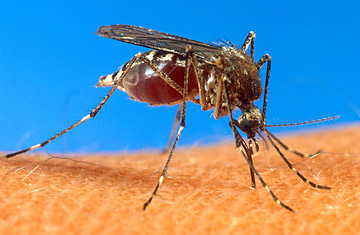
Most duets are blood-chillingly bad ("A Little Bit Country, A Little Bit Rock and Roll" by Donny and Marie Osmond springs to mind), and doubtless the mosquito's mating song ranks high among such perturbations. But the identification of a particular love ballad performed by Aedes aegypti, the mosquito responsible for spreading dengue and yellow fevers, has one group of Cornell University scientists whistling happily along.
"We've opened a new window of understanding on what mosquitoes are capable of doing," says Ronald Hoy, a professor of neurobiology and behavior at Cornell who participated in the research. The study may also present a new way of controlling the A. aegypti population. (See the top 10 animal stories of 2008.)
Why the fuss over this particular mosquito's mating call? First off, the findings, published in the Jan. 9 issue of the journal Science, dispel a few former assumptions about A. aegypti's behavior: that the female is deaf and a passive participant in the mating ritual and that the male cannot hear frequencies above 1,000 Hz. In fact, the Cornell researchers have established that both the male and female of this subtropical species can detect frequencies as high as 2,000 Hz and that they are equal participants in the courtship process.
While some mosquito species mate at dusk, A. aegypti engages in daytime rendezvouses. A male flies into a swarm to scope out potential mates, chasing a few specimens (see one such chase here) and checking them out at a range of 1 to 2 cm. If the female has recently mated, she'll rebuff the male's advances, but once a love connection is made, the two will adjust their wing speeds: females typically beat their wings at about 400 Hz, or beats per second, and males flap at a frequency of about 600 Hz; however, when two potential mates spy each other, they adjust their wing speeds to create a harmonic of about 1,200 Hz. Once the male satisfactorily matches the female's overtone, mating commences. (Unfortunately, scientists lack the technology to determine whether this harmonic convergence lasts throughout copulation.)
Recording the love song of A. aegypti was a rather complex affair: the Cornell researchers had to chill the mosquitoes into unconsciousness, put them under a microscope, affix a pin about the width of a human hair to the back of the insects and place tiny electrodes on their Johnston's organ (a.k.a. their ear), which is located at the base of their antennae. The electrodes registered any changes in frequency heard by the mosquitoes. "This is the first time anyone has ever recorded from a mosquito's ear," Hoy says.
Perhaps the most important implication of the Cornell group's efforts is that their discovery could one day be used to help control A. aegypti's population. Considering that the diseases the mosquito carries — dengue and yellow fevers, which together affect up to 100 million people a year, mostly in tropical and subtropical regions — recently made the Wildlife Conservation Society's Deadly Dozen wildlife-diseases list, winnowing A. aegypti's numbers has become a bit more urgent. Since this study offers proof that females are not promiscuous — they won't mate for a day or so following an act of copulation — scientists can try using lab-sterilized males to edge out their fertile competitors. But because mosquitoes are sterilized using radiation, it's unclear whether they function exactly like untouched mosquitoes, so Hoy hopes that his team's findings can someday be used to acoustically test these lab-reared males to ensure they're as willing and competent as the wild males to perform the mating duet.
Whatever the outcome of this study, don't expect to see an electronic pest-control device set to 1,200 Hz to block A. aegypti's mating call. At that frequency, Hoy says, "it would drive humans nuts."
